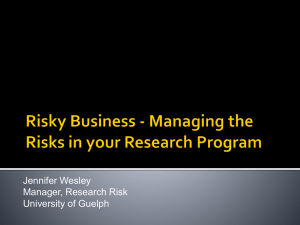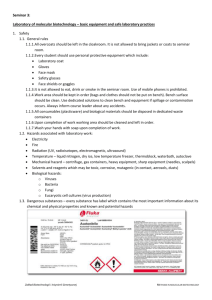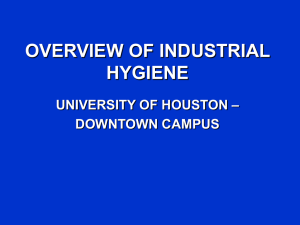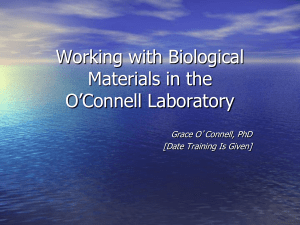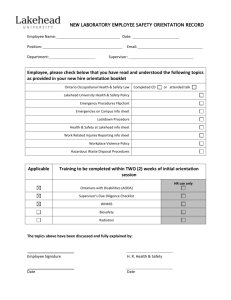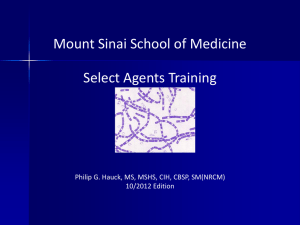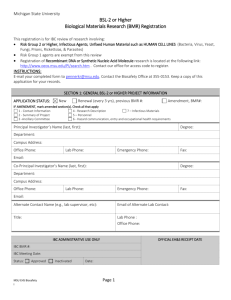Biosafety Forms for Teaching Labs
advertisement
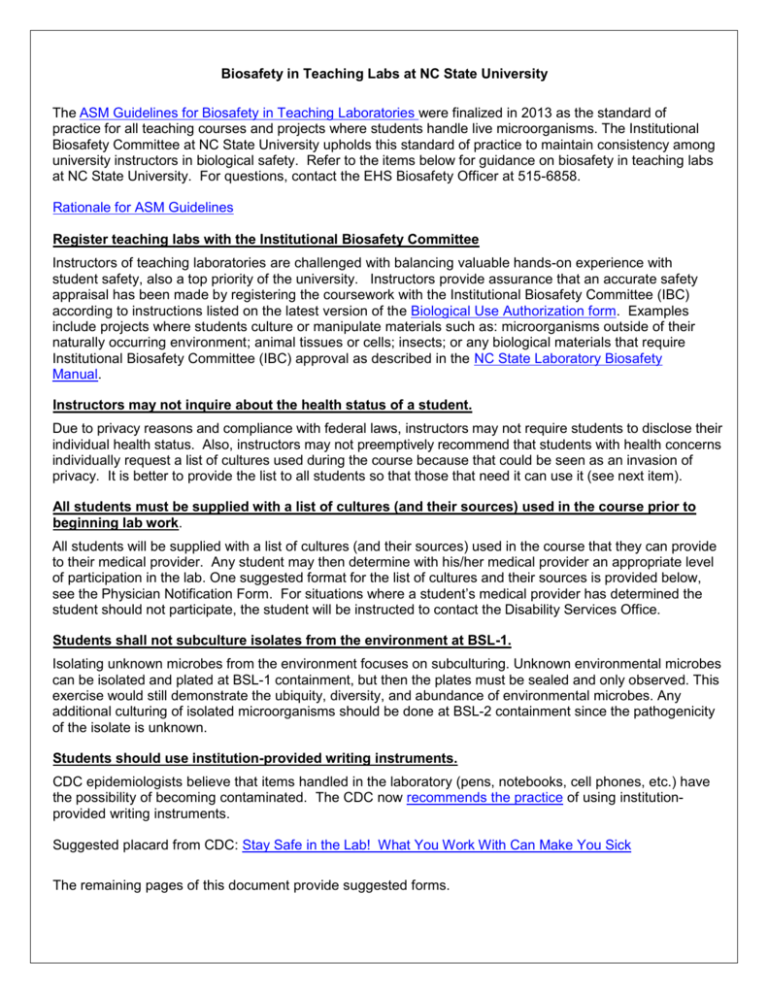
Biosafety in Teaching Labs at NC State University The ASM Guidelines for Biosafety in Teaching Laboratories were finalized in 2013 as the standard of practice for all teaching courses and projects where students handle live microorganisms. The Institutional Biosafety Committee at NC State University upholds this standard of practice to maintain consistency among university instructors in biological safety. Refer to the items below for guidance on biosafety in teaching labs at NC State University. For questions, contact the EHS Biosafety Officer at 515-6858. Rationale for ASM Guidelines Register teaching labs with the Institutional Biosafety Committee Instructors of teaching laboratories are challenged with balancing valuable hands-on experience with student safety, also a top priority of the university. Instructors provide assurance that an accurate safety appraisal has been made by registering the coursework with the Institutional Biosafety Committee (IBC) according to instructions listed on the latest version of the Biological Use Authorization form. Examples include projects where students culture or manipulate materials such as: microorganisms outside of their naturally occurring environment; animal tissues or cells; insects; or any biological materials that require Institutional Biosafety Committee (IBC) approval as described in the NC State Laboratory Biosafety Manual. Instructors may not inquire about the health status of a student. Due to privacy reasons and compliance with federal laws, instructors may not require students to disclose their individual health status. Also, instructors may not preemptively recommend that students with health concerns individually request a list of cultures used during the course because that could be seen as an invasion of privacy. It is better to provide the list to all students so that those that need it can use it (see next item). All students must be supplied with a list of cultures (and their sources) used in the course prior to beginning lab work. All students will be supplied with a list of cultures (and their sources) used in the course that they can provide to their medical provider. Any student may then determine with his/her medical provider an appropriate level of participation in the lab. One suggested format for the list of cultures and their sources is provided below, see the Physician Notification Form. For situations where a student’s medical provider has determined the student should not participate, the student will be instructed to contact the Disability Services Office. Students shall not subculture isolates from the environment at BSL-1. Isolating unknown microbes from the environment focuses on subculturing. Unknown environmental microbes can be isolated and plated at BSL-1 containment, but then the plates must be sealed and only observed. This exercise would still demonstrate the ubiquity, diversity, and abundance of environmental microbes. Any additional culturing of isolated microorganisms should be done at BSL-2 containment since the pathogenicity of the isolate is unknown. Students should use institution-provided writing instruments. CDC epidemiologists believe that items handled in the laboratory (pens, notebooks, cell phones, etc.) have the possibility of becoming contaminated. The CDC now recommends the practice of using institutionprovided writing instruments. Suggested placard from CDC: Stay Safe in the Lab! What You Work With Can Make You Sick The remaining pages of this document provide suggested forms. Department Name - Course Number SOP-1 Version 1-2014 =========================================================================== Informed consent for work in the e.g., PI name Laboratory Course Number under e.g., BSL-2 conditions Name (print): ________________________________ Instructions: This form must be completed by all faculty, staff, and students and returned to the instructor prior to entering room Room # in Building Name to work with organisms capable of causing disease including: List possible diseases here. My signature below indicates that I am aware of the risks involved when working with the organisms listed, understand the following, and agree to abide by the stated conditions: Treat all microorganisms as if they are pathogenic; this includes all broths, media enrichments, and foods used in all the laboratory exercises. Follow at all times aseptic techniques to prevent inadvertent contamination of samples, test media and other individuals in the lab. Follow at all times directions from the instructor or TA. For all laboratory exercises disposable gloves, lab coats, safety glasses, long pants/skirts and closed-toe shoes are required. There is to be ABSOLUTELY NO USE OF CELL PHONES OR ANY PERSONAL MOBILE/ELECTRONIC DEVICES OR EATING, DRINKING, SMOKING IN LABS-this includes candy, gum, snuff or tobacco use of any kind. Name of Agent and brief description of agent (e.g., characteristics, transmission risk in lab vs. in nature, typically symptoms). Press enter to add more agents. I fully understand that the risks involved with these activities can lead to illness, permanent disability, and/or death. I have been advised of the risks and treatments associated with infection and of the opportunity to discuss concerns with the following: o for students, contact Student Health Services at 919-515-2563; o for employees, contact the Student Health Services Occupational Medicine Program Administrator at 919-513-0277; or o my personal physician. I understand that if I am immune-compromised or living with or caring for an immune-compromised individual that I should consult my medical provider to determine the appropriate level of participation in the lab. I have been provided a Physician Notification Form (attached) for this purpose. Should my physician discern that I should not participate in this lab, I will have him or her write a note stating the concerns and return the note to the Director of Disability Services Office (DOS). The phone number for the DSO is (919) 515-7653. Alternative accommodations may be indicated. Pregnant or nursing mothers are also warned that participation in certain lab sessions may endanger the health or welfare of their unborn or newborn child. Such individuals should discuss this with their medical provider and may be advised not to participate in lab sessions. My signature indicates that I am aware of, understand, and agree to abide by the above stated conditions: Name (print): _________________________________ ID#: _________________________________ Signature: _________________________________ Date: _________________________________ Course and Number: _________________________________ Course Department: _________________________________ Instructor Name (print): _________________________________ Instructor Signature: _________________________________ =========================================================================== Instructor retains this form for a minimum of 4 years. PHYSICIAN NOTIFICATION FORM Many teaching labs at NC State University are operated at Biosafety Level 2 (BSL-2). Personal protective equipment (e.g., lab coat, gloves, goggles, etc.) is required to work in this lab, and access to the laboratory is restricted by the laboratory director when work with infectious agents is in progress. Persons who are immune-compromised (including those who are pregnant or may become pregnant) and students living with or caring for an immune-compromised individual should consult with physicians to determine the appropriate level of participation in the lab. Should your physician discern that you should not participate in this lab, please have him or her write a note stating the concerns. Return the note to the Director of Disability Services Office. Alternative accommodations may be indicated. Agents used in the e.g., BSL-2 lab include: Agent description including source. Press enter to add more agents. Biosafety Level 2 Teaching Lab Checklist1 A. Lab Physical Space Requirements - Does the laboratory space include: nonporous floor, bench tops, chairs, and stools? sink for handwashing? eyewash station? lockable door to the room? proper pest control practices? a storage area separate from work area for personal belongings? a working and validated autoclave in the building? Posted biohazard signage: wherever cultures are used and stored? on the door to the room? on any containers used to transport cultures? Recommended: Biological safely cabinet. The biological safety cabinet is required when using large volumes of culture or when a procedure which create aerosols. B. Stock Culture Requirements Only use cultures from authorized, commercial, or reputable sources (e.g., academic lab, state health department)? Cultures isolated from clinical specimens should not be used. Documents are maintained about stock organisms, sources, and handling of stock cultures? Fresh stock cultures of microorganisms obtained annually (e.g., purchased, revived from frozen stock cultures) to be certain of the source culture, minimize spontaneous mutations, and reduce contamination? Stock cultures kept in a secure area? C. Standard Lab Practices 1 Wash hands before and after the lab session Tie back long hair Disinfect bench before and after the lab session Disinfectant in use is known to kill the organisms handled Use disinfectants according to manufacturer instructions Do not bring food, gum, drinks (including water), or water bottles into the lab Do not touch the face, apply cosmetics, adjust contact lenses, or bite nails Do not handle personal items (cosmetics, cell phones, calculators, pens, pencils, etc.) while in the lab Do not mouth pipette Label all containers clearly Keep door closed while the lab is in session. Lab director or instructor approves all personnel entering the lab Minimize the use of sharps. Use needles and scalpels according to appropriate guidelines/precautions Use proper transport vessels (test tube racks) in the lab and store these in a leak proof container when work with them is complete Adopted from ASM Guidelines for Biosafety in Teaching Laboratories Use leak-proof containers for storage and transport of infectious materials Use micro-incinerators or disposable loops rather than Bunsen burners Use appropriate pest-control methods for rodents, insects, etc. Arrange for proper (safe) decontamination and disposal of contaminated material (e.g., in a properly maintained and validated autoclave) or arrange for licensed waste removal according to local, state, and federal regulations Do not handle broken glass with fingers; use dustpan and broom Notify instructor of all spills or injuries Document all injuries according to NC State policy (ncsu.edu/ehs) Keep note-taking and discussion practices separate from work with hazardous or infectious material Use only institution-provided marking pens and writing instruments Teach, practice, and enforce proper wearing and use of gloves, lab coats, protective eyewear, & close-toed shoes. Require immune-compromised students (including those who are pregnant or may become pregnant) and students living with or caring for an immune—compromised individual to consult physicians to determine the appropriate level of participation in the lab D. Training Practices Be aware that student assistants may be employees of the institution and subject to OSHA, state, and/or institutional regulations Conduct extensive initial training for instructors and student assistants to cover the safety hazards of each lab. The institution’s biosafety officer or microbiologist in charge of the labs should be included in the training. Conduct training for instructors whenever a new procedural change is required Conduct training for student assistants annually Require students and instructors to handle microorganisms safely and responsibly Require students to demonstrate competency at BSL1 before working in a BSL2 laboratory Inform students of safety precautions relevant to each exercise before beginning the exercise Emphasize to students the importance of reporting accidental spills and exposures E. Document Practices Require students to sign safety agreements explaining that they have been informed about safety precautions and the hazardous nature of the organisms they will handle throughout the course Maintain student-signed safety agreements/waivers at the institution Prepare, maintain, and post proper signage Document all injuries and spills; follow university policy as indicated in the NC State Laboratory Biosafety Manual. Make Material Safety Data Sheets (MSDS) available at all times Post emergency procedures and updated contact information in the lab Maintain a list of all cultures (and their sources) used in the course Keep a biosafety manual specific to the laboratory and/or course in the lab Keep a copy of the current version of Biosafety in Microbiological and Biomedical Laboratories (BMBL) in the lab
